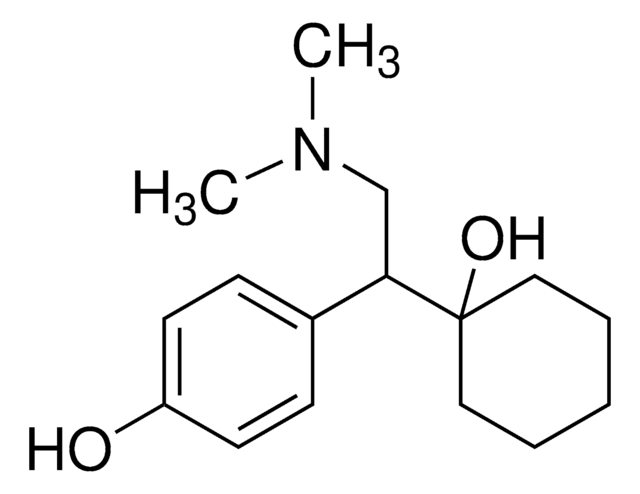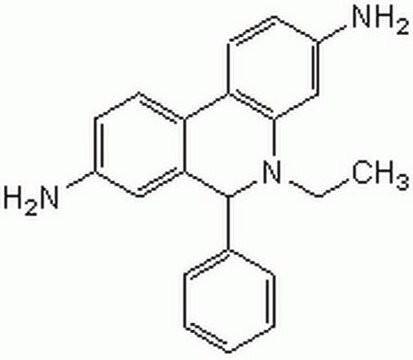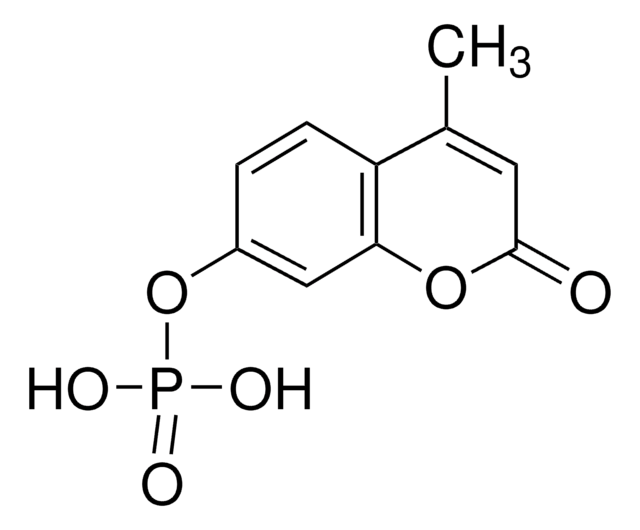APF
Alkaline Phosphatase Detection Kit, Fluorescence
Iniciar sesiónpara Ver la Fijación de precios por contrato y de la organización
About This Item
Productos recomendados
Descripción general
The Alkaline Phosphatase (AP) Kit uses a fluorometric assay to detect AP activity. The kit capability is linear over a wide range of enzyme concentrations, which makes it particularly well suited for comparative analysis.
The gene for alkaline phosphatase (AP) commonly serves as a reporter gene and is used to determine the strength of promoters and enhancers, define the role of transcription factors, assess transfection efficiency and measure the success of molecular cloning attempts. The alkaline phosphatase (AP) kit uses a fluorometric assay to detect AP activity. The kit capability is linear over a wide range of enzyme concentrations, which makes it particularly well suited for comparative analysis.
Aplicación
Alkaline Phosphatase Detection Kit, Fluorescence has been used to determine alkaline phosphatase (ALP) activity.
Suitable for measuring the alkaline phosphatase (AP) or secreted alkaline phosphatase (SEAP)reporter gene activity. The Alkaline Phosphatase Kit can be used to determine the strength of promoters and enhancers, define the role of transcription factors, assess transfection efficiency, and measure the success of molecular cloning attempts.
Also suitable for detection of AP activity in pluripotent stem cells, including embryonic stem cells (ESCs) and induced pluripotent stem cells (iPSCs).
Also suitable for detection of AP activity in pluripotent stem cells, including embryonic stem cells (ESCs) and induced pluripotent stem cells (iPSCs).
Acciones bioquímicas o fisiológicas
Alkaline phosphatase (ALP) helps in hydrolyses and transphosphorylation of several phosphoric acid monoesters. It modulates various intracellular processes, that are associated with cell cycle, apoptosis, growth and signal transduction pathways.
Características y beneficios
- Up to 100x more sensitive than colorimetric assays
- SEAP can be measured without sample destrutcion
- Rapid and reproducible results
- Safe and easy-to-use
Componentes
The Alkaline Phosphatase Kit contains:
50mL Fluorescent Assay Buffer ( B6558)
6 mL Dilution Buffer (B6433)
50 μl Alkaline Phosphatase Control Enzyme, 0.1 mg/mL (C9361)
2 x 1 mg 4-Methylumbelliferyl phosphate disodium (M8168)
50mL Fluorescent Assay Buffer ( B6558)
6 mL Dilution Buffer (B6433)
50 μl Alkaline Phosphatase Control Enzyme, 0.1 mg/mL (C9361)
2 x 1 mg 4-Methylumbelliferyl phosphate disodium (M8168)
Producto relacionado
Referencia del producto
Descripción
Precios
Código de clase de almacenamiento
10 - Combustible liquids
Punto de inflamabilidad (°F)
Not applicable
Punto de inflamabilidad (°C)
Not applicable
Certificados de análisis (COA)
Busque Certificados de análisis (COA) introduciendo el número de lote del producto. Los números de lote se encuentran en la etiqueta del producto después de las palabras «Lot» o «Batch»
¿Ya tiene este producto?
Encuentre la documentación para los productos que ha comprado recientemente en la Biblioteca de documentos.
Los clientes también vieron
An impedimetric determination of alkaline phosphatase activity based on the oxidation reaction mediated by Cu 2+ bound to poly-thymine DNA
Lee JY, et al.
Royal Society of Chemistry Advances, 8(20), 11241-11246 (2018)
Endofin acts as a Smad anchor for receptor activation in BMP signaling
Shi W, et al.
Journal of Cell Science, 120(7), 1216-1224 (2007)
Irena Moserova et al.
PloS one, 7(3), e32972-e32972 (2012-03-10)
We have analyzed the molecular mechanisms of photoinduced cell death using porphyrins with similar structure differing only in the position of the ethylene glycol (EG) chain on the phenyl ring. Meta- and para-positioned EG chains targeted porphyrins to different subcellular
Caterina Bossio et al.
Frontiers in bioengineering and biotechnology, 6, 114-114 (2018-09-14)
Optical modulation of living cells activity by light-absorbing exogenous materials is gaining increasing interest, due to the possibility both to achieve high spatial and temporal resolution with a minimally invasive and reversible technique and to avoid the need of viral
Jean-Charles Cadoret et al.
The Journal of biological chemistry, 280(40), 33935-33944 (2005-08-13)
Cyclic nucleotides cAMP and cGMP are ubiquitous signaling molecules that mediate many adaptative responses in eukaryotic cells. Cyanobacteria present the peculiarity among the prokaryotes of having the two types of cyclic nucleotide. Cellular homeostasis requires both cyclases (adenylyl/guanylyl, for their
Nuestro equipo de científicos tiene experiencia en todas las áreas de investigación: Ciencias de la vida, Ciencia de los materiales, Síntesis química, Cromatografía, Analítica y muchas otras.
Póngase en contacto con el Servicio técnico








